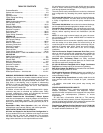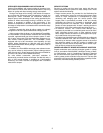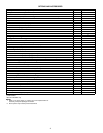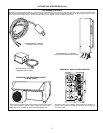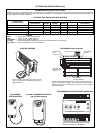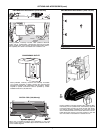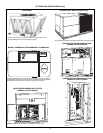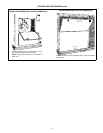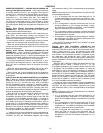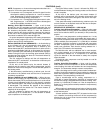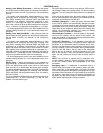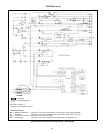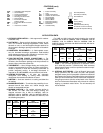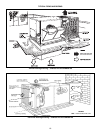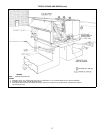10
CONTROLS
OPERATING SEQUENCE — 548F036-120 AND 549B036-120
Cooling, Units Without Economizer —
When thermostat calls
for cooling, terminals G and Y1 are energized. The indoor-fan
contactor (IFC), reversing valve solenoid (RVS1) and compres-
sor contactor no. 1 (C1) are energized and indoor-fan motor,
compressor no. 1, and outdoor fans start. The outdoor-fan
motor(s) run continuously while unit is cooling. On 548F090-
120 units, if the thermostat calls for a second stage of cooling
by energizing Y2, compressor contactor no. 2 (C2) and revers-
ing valve solenoid (RVS2) are energized and compressor no. 2
starts.
Heating, Units Without Economizer (548F036-072 and
549B036-072) —
Set system switch at AUTO. or HEAT position.
Set thermostat at desired temperature.
When the thermostat calls for heat, the IFC, outdoor-fan con-
tactor (OFC), and compressor contactor are energized. The
RVS is deenergized and switches position, and the indoor fan,
outdoor fan, and compressor are energized.
If the thermostat calls for a second stage of heat, the heater
contactor (HC) is energized and starts the electric heaters.
When the space temperature approaches the heating tem-
perature set point, heating stages cycle off. The reversing valve
solenoid is reenergized.
Heating, Units Without Economizer (548F090-120 and
549B090,120) —
Upon a request for heating from the space
thermostat, terminal W1 will be energized with 24 v. The IFC,
outdoor-fan contactor (OFC), C1, and C2 will be energized. The
reversing valves switch position and the indoor fan, outdoor fan,
compressor no. 1, and compressor no. 2 are energized.
If the space temperature continues to fall while W1 is ener-
gized, W2 will be energized with 24 v, and the heater contac-
tor(s) (HC) will be energized, which will energize the electric
heater(s).
When the space thermostat is satisfied, W2 will be deen-
ergized first, and the electric heater(s) will be deenergized.
Upon a further rise in space temperature, W1 will be deener-
gized, and the reversing valve solenoids (RVS1 and RVS2) will
be energized.
Cooling, Units With EconoMi$er (548F036-072 and 549B036-
072) —
When the outdoor-air temperature (OAT) is above the
ECON SP set point and the room thermostat calls for Stage 1
cooling (R to G + Y1), the indoor-fan motor (IFM) is energized
and the EconoMi$er damper modulates to minimum position.
The compressor contactor is energized to start the compressor
and outdoor-fan motor (OFM) and RVS1 (reversing valve sole-
noid). After the thermostat is satisfied, the damper modulates to
the fully closed position when the IFM is deenergized.
When the OAT is below the ECON SP setting and the room
thermostat calls for Stage 1 cooling (R to G + Y1), the
EconoMi$er modulates to the minimum position when the IFM
is energized. The EconoMi$er provides Stage 1 of cooling by
modulating the return and outdoor-air dampers to maintain a
55 F supply air set point. If the supply-air temperature (SAT) is
greater than 57 F, the EconoMi$er modulates open, allowing a
greater amount of outdoor air to enter the unit. If the SAT drops
below 53 F, the outdoor air damper modulates closed to reduce
the amount of outdoor air. When the SAT is between 53 and
57 F, the EconoMi$er maintains its position.
If outdoor-air alone cannot satisfy the cooling requirements of
the conditioned space, and the OAT is above the MECH CLG
LOCKOUT set point, the EconoMi$er integrates free cooling
with mechanical cooling. This is accomplished by the strategies
below.
NOTE:
Compressor has a 2-minute Minimum On, Minimum Off,
and Interstage delay timer.
1. If Y1 is energized, and the room thermostat calls for Y2
(2-stage thermostat), the compressor and OFM are ener-
gized. The EconoMi$er damper is maintained at its current
position.
2. If Y1 is energized for more than 20 minutes, and Y2 is not
energized (whether or not a 2-stage thermostat is used),
the compressor and OFM are energized. The EconoMi$er
damper is maintained at its current position.
3. If Y1 is energized, and the compressor is already energized
(see Step 2) and the room thermostat calls for Y2, the com-
pressor continues to operate.
4. If compressor is energized and the thermostat is satisfied,
the compressor, the OFM, and IFM are deenergized and
the EconoMi$er modulates closed.
When the OAT is below the MECH CLG LOCKOUT set point,
the compressors remain off.
Cooling, Units With EconoMi$er (548F090-120 and
549B090,120) —
When the outdoor-air temperature (OAT) is
above the ECON SP set point and the room thermostat calls for
Stage 1 cooling (R to G + Y1), the indoor-fan motor (IFM)
is energized and the EconoMi$er damper modulates to mini-
mum position. The compressor contactor is energized to start
the compressor and outdoor-fan motor (OFM) and RVS1
(reversing valve solenoid). After the thermostat is satisfied, the
damper modulates to the fully closed position when the IFM is
deenergized.
When the OAT is below the ECON SP setting and the room
thermostat calls for Stage 1 cooling (R to G + Y1), the
EconoMi$er modulates to the minimum position when the IFM
is energized. The EconoMi$er provides Stage 1 of cooling by
modulating the return and outdoor-air dampers to maintain a
55 F supply air set point. If the supply-air temperature (SAT) is
greater than 57 F, the EconoMi$er modulates open, allowing a
greater amount of outdoor air to enter the unit. If the SAT drops
below 53 F, the outdoor air damper modulates closed to reduce
the amount of outdoor air. When the SAT is between 53 and
57 F, the EconoMi$er maintains its position.
If outdoor-air alone cannot satisfy the cooling requirements of
the conditioned space, and the OAT is above the MECH CLG
LOCKOUT set point, the EconoMi$er integrates free cooling
with mechanical cooling. This is accomplished by the strategies
below.
NOTE:
Compressors have a 2-minute Minimum On, Minimum
Off, and Interstage delay timer.
1. If Y1 is energized, and the room thermostat calls for Y2
(2-stage thermostat), compressor no. 1 and OFM are ener-
gized. The EconoMi$er damper is maintained at its current
position.
2. If Y1 is energized for more than 20 minutes, and Y2 is not
energized (whether or not a 2-stage thermostat is used),
compressor no. 1 and OFM are energized. The EconoMi$er
damper is maintained at its current position.
3. If Y1 is energized, and compressor no. 1 is already ener-
gized (see Step 2) and the room thermostat calls for
Y2, compressor no. 1 continues to operate. If Y2 remains
energized for more than 20 minutes, compressor no. 2 is
energized.



